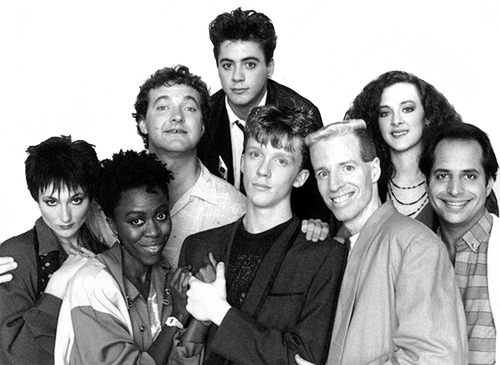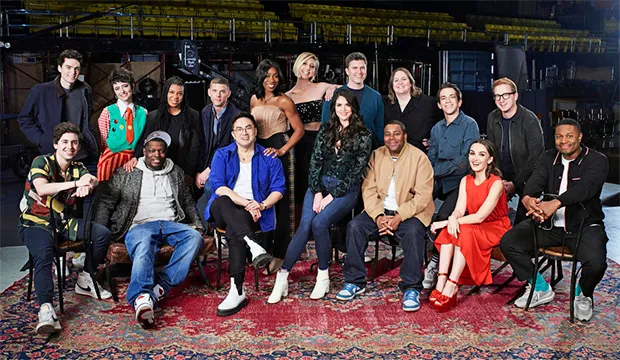
- The Not Ready for Prime Time Era. (S1-5) This was the Great Experiment in late-night comedy that established most of the format we enjoy today and introduced a troupe of comic actors to the world as superstars. It represents Lorne Michaels tinkering with elements like the Muppets and stand-up comic segments but also high-profile musical guests and Weekend Update – elements that would establish the format for the entire half-century of the show. It is also the era against which all other “eras” will be compared. It survived the loss of Chevy Chase early on, but the departure of John Belushi and Dan Aykroyd in Season 5 was a sign that the glory days were coming to an end. Still, it was a golden age where anything could happen live. Monty Python members might show up. Steve Martin will probably host. The Rolling Stones might just walk into a sketch. Hell, the Beatles might reunite to collect that $3000 check Lorne offered. It was good AND bad, but it was a glorious ride.

- The Lost Era. (S6-9) With the departure of Michaels and the original cast due to burnout and career opportunities, the show fell into a darker, rudderless period where it could never find its voice at the start of a new decade. Despite having comic actors from the same background as the original NRfPTPs like Robin Duke, Tony Rosato, and Tim Kazurinsky, the counter-culture wave of comedy that made the original cast into rock stars had broken. The new cast fell victim to unfair comparisons to the original but also lacked the charisma or star power of the original company – save breakout star Eddie Murphy, who remains one of the show’s few highlights despite having great talent in the cast. He is credited with saving the show from oblivion and remains arguably the biggest name to come out of SNL’s great history.

- The Big Ticket Season (S10) The show had a notable bounce in quality and popularity in Season 10 when Producer Dick Ebersol tried to make up for the loss of Eddie Murphy with established comic actors like Martin Short, Billy Crystal, Chris Guest, and Pamela Stephenson – but despite providing some of the “Lost Era’s” best work, Ebersol’s departure and Michaels’ return resulted in a major change in the show’s direction.

- The Rebuilding Year. (Season 11) This was Lorne Michael’s rebuilding year as he returned to the show, bringing along with him some of the original talents behind the camera to help him. This group was a mixed bag of different styles and voices that didn’t quite work. It did see Al Franken back as a writer and performer and introduced future Renaissance Era players Dennis Miller, Nora Dunn, and Jon Lovitz. It resembled the first season of SNL in a lot of ways in terms of its willingness to experiment, but it didn’t have the support or novelty of being a “fresh and new” enterprise and so Michaels started over again the following year with S12 host Madonna announcing that this season was “all a terrible dream.”

- The Renaissance Era (S12-S16) With a format largely established and a strong cast (which could arguably be called ‘The Phil Hartman Era’) the show finally stood on its own with strong sketchwork, recurring characters, popular players, and great writing that saved the show from obscurity and establishing it as a television institution. It established Weekend Update under Dennis Miller as the “fake news” template for others to copy. It was a period of memorable recurring characters who were spun off into movies, especially the highly successful Mike Myers-Dana Carvey-led Wayne’s World.

- The Frat Boy Era (S17-20) As Phil Hartman prepared to move on from the show, Michaels identified that SNL could not afford to rebuild from scratch every few years and keep its momentum. He started to cycle new players into the company to try and replace the big stars and less-popular repertory and featured players. This is the year that Dana Carvey, Mike Myers, and Hartman began to shift screentime to newer players like Chris Farley, Chris Rock, David Spade, Rob Schneider, and of course Adam Sandler to present more youth-oriented comedy and character work. The end of this era also marks the removal of Head Writer Jim Downey (who remained on staff) for the first time since Michaels’ return to the show.

- The Ensemble Era (S21-26) This could also be referred to as “The Will Ferrell Era” but it represents a shift from the adolescent, loud humor of what went on to become Adam Sandler’s “Happy Madison” troupe of former SNL-players to a more balanced ensemble of imaginative, sometimes surreal comedy. This period is defined largely by Ferrell’s character work but also includes memorable sketches supervised by Tina Fey for probably the most consistently strong repertory companies of SNL’s history. It is also notable for sketches more memorable because of cast members “breaking” scenes (Fallon and Sanz, usually) more than their content. This era marks the beginning of a more “populist” comedy style that recognized that SNL was trying to appeal to multiple generations of fans so the sketches were aimed at a broader appeal than the previous era’s attempt to draw in a more exclusively younger audience.

- The Female Renaissance Era (S27-30) With female players like Tina Fey, Ana Gasteyer, Amy Pohler, Rachel Dratch, and Maya Rudolph emerging as top performers of the era, the show began to mature in its rounded approach to comedy. Perhaps in response to former cast members describing their negative experiences as women working on the show, SNL began casting and giving voice to more women in key roles. It marked the period where a woman (Fey) was Head (or co-head) Writer for the show) and the WU desk was anchored by two women. The result was an improvement in the level of comedy that appealed to a wider audience.

- The Viral Video Era (S31-36) Another major transition for SNL took the form of an increased emphasis on pre-taped content and created “viral moments” that could be viewed by a much larger audience after the live broadcast. The addition of Andy Samberg and “The Lonely Island” represents an extension and expansion of SNL’s tradition of creating short pre-taped content to provide time to set up for live sketches. It also recognized a younger audience that was getting more of its entertainment through social media rather than “appointment television”. It also marked a transition in the writing style to more political and high-concept comedy under the writing supervision of Seth Meyers intended to be provocative as much as innovative. It would also be the era of breakout player Kristen Wiig, the only player to be sent off the show serenaded by the Rolling Stones in an on-camera party. This period is represented by bold attempts to create those SNL recurring character and catchphrase moments in provocative short videos that would gain traction on YouTube, creating memorable moments like “Dick in a Box” and Natalie Portman’s rap videos.


- The New Modern Era (S37-49) This period of SNL seems to be the most stable in terms of content. It begins with a transition from the greats like Fred Armisen, Jason Sudekis, Bill Hader, and Kristen Wiig to a new company featuring longer-serving and popular players Vanessa Beyer, Taran Killam, Aidy Bryant, Kate McKinnon, and Cecily Strong. Of course, this is the start of perennial player Kenan Thompson as well. It also represents the transition from Seth Meyer’s era as WU anchor and Head Writer to Colin Jost who created the long-standing “frenemy” co-anchor relationship with Michael Che. It also represents the start of SNL’s recognition of its need to be more diverse and to represent different voices of its viewing audience.
The practice of cycling new talent in to mix with established players continued in this era making it easier to “lose” a cast member to film or television opportunities. The total cast has grown in recent years, but the show is less reluctant to phase out players who just don’t find their voice in the cast. This period also represents some of the longest-serving players in SNL history. Beyond Kenan Thompson (now entering his 22nd season), Jost, McKinnon, Strong, Bryant, and Che logged ten seasons in this era. Kyle Mooney served 9. Beck Bennet, Pete Davidson, and Mikey Day have 8 seasons. This stability allows the show to cycle in and try out new talent while drawing viewers back to familiar, established players.
While the shift toward more pre-taped content (including the popular “Please Don’t Destroy” shorts) is part of SNL tradition, it appears to be a logistical necessity in a live show with such a large cast and expensive set and costume changes that must be carried out in real time. While the original thrill of SNL was in that “anything can happen” environment, the era of cheap, minimalist sets and costumes will not work in 4K big screens. Time to prepare these changes makes the pre-tapes vital to the success of each sketch. The quality and variety of these sketches has developed from short auteur pieces by Albert Brooks, Adam McKay, Robert Smigel, and others to more collaborative and complicated music videos and even period pieces. These longer segments have become more involved over the years and have become their own attraction online and live.
Despite all the changes in players, the format of the show and its approach to comedy have remained largely the same for fifteen years, adapting to different trends, but reflecting a more balanced approach to satire, political humor, and surrealist/farcical comedy.
As it’s fiftieth anniversary approaches, I wonder what the next era will be like and how much of a role creator Lorne Michaels will play in it.
Leave a comment